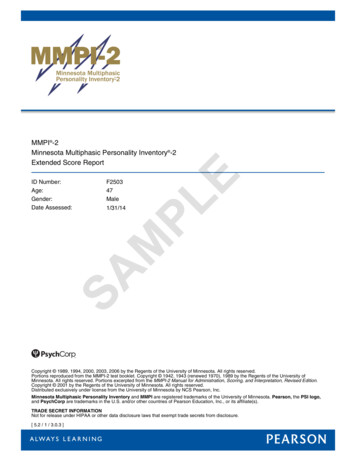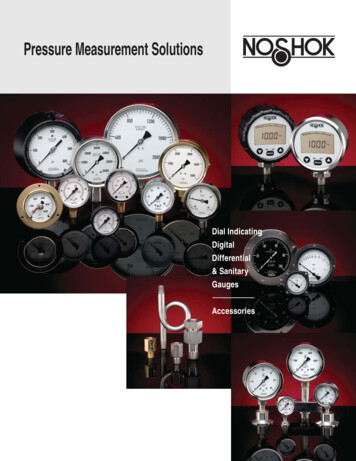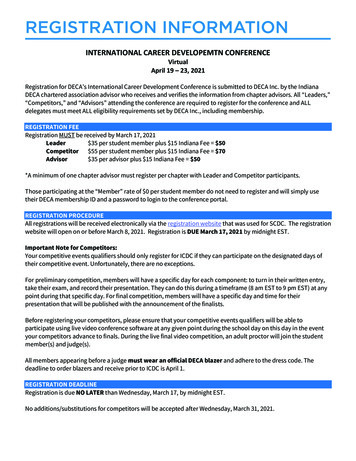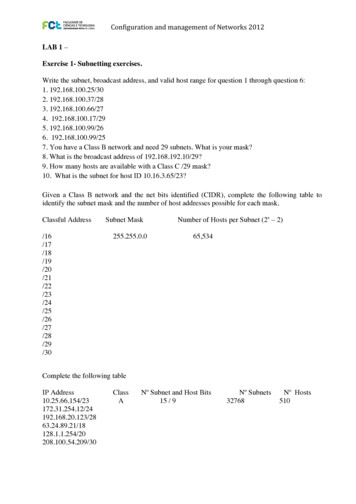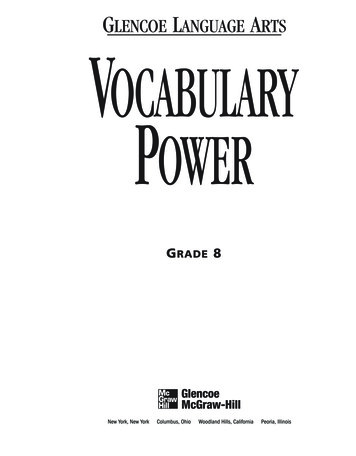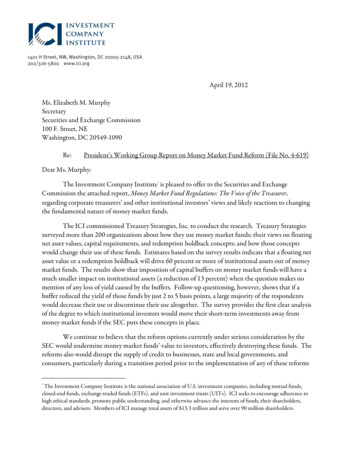
Transcription
April 19, 2012Ms. Elizabeth M. MurphySecretarySecurities and Exchange Commission100 F. Street, NEWashington, DC 20549-1090Re:President’s Working Group Report on Money Market Fund Reform (File No. 4-619)Dear Ms. Murphy:The Investment Company Institute* is pleased to offer to the Securities and ExchangeCommission the attached report, Money Market Fund Regulations: The Voice of the Treasurer,regarding corporate treasurers’ and other institutional investors’ views and likely reactions to changingthe fundamental nature of money market funds.The ICI commissioned Treasury Strategies, Inc. to conduct the research. Treasury Strategiessurveyed more than 200 organizations about how they use money market funds; their views on floatingnet asset values, capital requirements, and redemption holdback concepts; and how those conceptswould change their use of these funds. Estimates based on the survey results indicate that a floating netasset value or a redemption holdback will drive 60 percent or more of institutional assets out of moneymarket funds. The results show that imposition of capital buffers on money market funds will have amuch smaller impact on institutional assets (a reduction of 13 percent) when the question makes nomention of any loss of yield caused by the buffers. Follow-up questioning, however, shows that if abuffer reduced the yield of those funds by just 2 to 5 basis points, a large majority of the respondentswould decrease their use or discontinue their use altogether. The survey provides the first clear analysisof the degree to which institutional investors would move their short-term investments away frommoney market funds if the SEC puts these concepts in place.We continue to believe that the reform options currently under serious consideration by theSEC would undermine money market funds’ value to investors, effectively destroying these funds. Thereforms also would disrupt the supply of credit to businesses, state and local governments, andconsumers, particularly during a transition period prior to the implementation of any of these reforms*The Investment Company Institute is the national association of U.S. investment companies, including mutual funds,closed-end funds, exchange-traded funds (ETFs), and unit investment trusts (UITs). ICI seeks to encourage adherence tohigh ethical standards, promote public understanding, and otherwise advance the interests of funds, their shareholders,directors, and advisers. Members of ICI manage total assets of 13.3 trillion and serve over 90 million shareholders.
Ms. Elizabeth M. MurphyApril 19, 2012Page 2when investors likely would rapidly move short-term investments from money market funds and intoalternative products and investments. Treasurers responding to the survey reported that they wouldmove their holdings currently invested in money market funds to a variety of options, including bankchecking accounts; separately managed outside accounts; government securities; commercial paper;local government investment pools; unregistered cash pools; repurchase agreements; and offshorefunds. To the extent that these products or investments are either less regulated or less transparentthan money market funds, implementing these reforms could well increase the risks to the financialsystem and reduce regulators’ ability to monitor financial markets.As regulators continue to explore the appropriateness of additional money market fundreforms, it is critical that any new regulations be carefully considered to ensure that they are consistentwith creating a stronger, more resilient product that serves the needs of short-term investors andborrowers, without imposing harmful, unintended consequences on financial markets or on the U.S.economy.We urge the SEC to give full consideration to the results of this report, and we appreciate theopportunity to provide additional information related to the Report of the President’s Working Groupon Money Market Fund Reform Options. If you have any questions or if we can provide any additionalinformation, please contact me at 202-326-5815 or Brian Reid, ICI Chief Economist, at 202-326-5917.Sincerely yours,/s/ Karrie McMillanKarrie McMillanGeneral CounselAttachmentcc:The Honorable Mary L. SchapiroThe Honorable Elisse B. WalterThe Honorable Luis A. AguilarThe Honorable Troy A. ParedesThe Honorable Daniel M. GallagherEileen Rominger, Director, Division of Investment ManagementRobert E. Plaze, Deputy Director, Division of Investment ManagementPaul Schott Stevens, President & CEO, Investment Company Institute
Money Market Fund Regulations:The Voice of the TreasurerApril 2012 2012 Treasury Strategies, Inc. All rights reserved.
Study Commissioned by theInvestment Company Institute
ContentsExecutive LetterOverview & Participant DemographicsFindings & Conclusions ! ! ! !Floating NAVRedemption HoldbackLoss Reserve/Capital BufferOutflow of Corporate MMF AssetsAppendix ! ! ! ! !MethodologyInvestment Behavior FindingsSurvey InstrumentTelephone Interview ScriptAbout Treasury Strategies, Inc.3!
April 9, 2012Investment Company Institute1401 H St., NWSuite 1200Washington, DC 20005Re: Proposed Regulations to Money Market FundsTreasury Strategies, the world’s leading consulting firm in the area of treasury,payments, and liquidity management, is pleased to present Money Market FundRegulations: The Voice of the Treasurer, a report sponsored by the InvestmentCompany Institute.The objective of this analysis is to provide a thorough understanding of the view ofcorporate treasury executives toward current money fund regulatory proposals, andto assess their likely behaviors should any be enacted. We examined threeproposals: The Floating Net Asset Value (NAV)The Redemption HoldbackThe Loss Reserve/Capital BufferWe surveyed 203 financial executives representing corporate, government, andinstitutional investors between February 13, 2012 and March 6, 2012. Therespondents are sophisticated investors (executives with treasury and cashmanagement responsibilities for their institutions) with 61% of them overseeingshort-term investment pools of 100 million or more.As detailed in the report, the reaction from this cross section of U.S. institutionalinvestors was overwhelmingly negative. For each of the three proposals, themajority of treasurers surveyed indicated that if enacted, they would eitherdecrease or discontinue their use of money market funds. Analyses by industry andby company size show that this sentiment is pervasive. There were no materialdifferences by respondent sector.Floating Net Asset ValueIf money fund NAVs were required to float: None of the respondents currently invested in MMFs would increase theirlevel of investments in money funds.21% would continue using funds at the same level.79% would either decrease use or discontinue altogether.Should this regulation be enacted, we estimate that money market fundassets held by corporate, government and institutional investors would seea net decrease of 61%.
Redemption HoldbackIf money market funds were required to institute a 30-day holdback of 3% of allredemptions: 10% of the respondents currently invested in MMFs would continue usingfunds at the same level.90% of respondents would either decrease their use or discontinuealtogether.Should this regulation be enacted, we estimate that the money market fundassets held by corporate, government and institutional investors would seea net decrease of 67%.Loss Reserve/Capital BufferIf money market funds were required to maintain a loss reserve or capital buffer: 8% of the respondents currently invested in MMFs would increase theirlevel of investments in money funds.56% would continue using funds at the same level.36% would either decrease their use or discontinue altogether.However in a follow-up question, if the cost of the reserve or capital were to reducethe yield of the fund: 53% of those respondents to the follow-up, who originally answered thatthey would continue or increase usage, would decrease or stop usage ofMMFs if the yield were to decrease by 2bp or more (0.02%).92% of those respondents to the follow-up, who originally answered thatthey would continue or increase usage, would decrease or stop usage ofMMFs if the yield were to decrease by 5bp or more (0.05%).ConclusionsOn the basis of this comprehensive analysis, Treasury Strategies concludes thatcorporate, government and institutional investors will respond negatively to each ofthese three proposals. The overwhelming majority of treasurers will either scaleback their use of money market funds or discontinue use of them altogether.We further conclude that corporate treasurers: View money market funds as an essential cash management toolUse them intensivelyUnderstand the risks, the returns and the tradeoff between the twoThe clear message of our research is that should any of these proposals beadopted, treasurers will act as one accord and simply abandon MMFs.Respectfully,Treasury Strategies, Inc.
Overview & ParticipantDemographics
Overview & ParticipantDemographicsTreasury Strategies surveyed 203 unique corporate, government, and institutional investors between Feb 13,2012 and March 6, 2012. The respondents are sophisticated investors (corporate treasury executives) with 61%of them overseeing short-term investment pools of 100 million or more.The executives surveyed were selected from the Treasury Strategies proprietary database of diverse financialexecutives. The set of responses included both large and small corporate, institutional, and government entities,across multiple industries. The respondents represent approximately 176.5 billion in total short-term investmentassets, and 58.5 billion in total money market fund assets.Survey respondents were asked 31 questions concerning: ! Their cash pools, ! Their investment objectives, and ! The three regulatory issuesThe survey was executed through a web-based instrument, with follow-up emails conducted for points ofclarification. These were followed by phone interviews with a sample of 15 respondents. For each of the threeregulatory issues, the executives were given a short statement of the issue, followed by an argument for and anargument against the proposal. This was to ensure balance in understanding and an objective response.Follow-up in-depth telephone interviews both confirmed and reinforced the findings. The attached pages ofverbatim comments illustrate the intensity of the respondents’ reactions.5!
Overview & ParticipantDemographicsTreasury Strategies’ survey is comprised of 203 unique respondents. Key demographic information is detailedbelow:The largest share of respondents have annualrevenues between 1 billion- 10 billion.All of the respondents have roles in UStreasury departments or within overseastreasury departments that have US cashoperations.203 RespondentsRespondent organizational titles include thefollowing: ! Chief Executive Officer ! Chief Financial Officer ! Treasurer ! Assistant Treasurer ! Treasury Manager ! Director of Finance203 Respondents203 Respondents6!
Overview & ParticipantDemographicsTreasury Strategies’ survey is comprised of 203 unique respondents. Participant industry distribution is shownbelow.7!
Overview & ParticipantDemographicsAt a high-level, the participant industry distribution is shown below. Detailed industries were grouped as follows:Services ! Communications/Media ! Retail ! Software/High-Tech ! Business Services ! Transportation ! Consulting ! Health Services ! OtherIndustrial ! Manufacturing ! Utilities ! Energy & Petroleum ! Wholesale ! Mining ! Construction ! OtherFinance, Insurance, Real Estate ! Financial Services ! Insurance ! Real Estate ! OtherIndustry ialFinance, Insurance,Real EstateNot For ProfitNot-For-Profit ! Government ! Higher Education ! Not-For-Profit ! Other8!
Findings & Conclusions ! ! ! !Floating NAVRedemption HoldbackLoss Reserve/Capital BufferOutflow of Corporate MMFAssets
Findings & ConclusionsFloating NAV ProposalSurvey Question:There is a proposal to change MMFs from a constant 1 net asset value (NAV) to a floating net asset value. Undertypical market conditions, it is anticipated that the share prices would fluctuate within a very narrow range.Proponents say this will ensure everyone pays and receives a price that automatically reflects any gains or lossesand that it reduces the potential for runs on MMFs during adverse situations.Opponents argue that a floating NAV would impair the use of funds as a liquidity instrument, as well as cause otherlegal, accounting, tax, and market disruptions.If the floating NAV proposal were enacted, what action would your organization most likely take?A.!B.!C.!D.!Increase use of MMFsContinue using MMFs at current levelDecrease use of MMFsStop using MMFs entirely10!
Findings & ConclusionsFloating NAV ProposalIf the floating NAV proposal were enacted, what action would your organization most likely take?*136 Respondents79% of current MMF user respondents wouldeither decrease or stop using MMFs, giventhe enactment of the floating NAV proposal.61 Respondents98% of non-MMF users would continue toavoid investing in MMFs under the floatingNAV proposal.Based on survey responses, we estimate that total corporate assets in MMFs would see a net decreaseof 61% due to this proposal.* Responses from participants who were not currently invested in MMFs were acquired because theymay be periodic users of MMFs who are not currently invested in MMFs. Page 13 provides a detailedbreakdown of respondents.11!
Findings & ConclusionsFloating NAV ProposalIf the floating NAV proposal were enacted, what action would your organization most likely take?Of the current MMF users that responded that they wouldstop or decrease use of MMFs, nearly three-fourths saidthat they would decrease MMF usage by at least 50%.136 Respondents108 Respondents12!
Findings & ConclusionsFloating NAV Proposal–By SegmentIf the floating NAV proposal were enacted, what action would your organization most likely take?IncreaseUsageContinue atCurrent LevelDecreaseUsageStop 39Financial Services,Insurance, Real Estate09111434NFP0612826 1B010171845 1B 018442991 250M014292063 250M 014322773 75M014322066 75MM 014292770Currently in MMF Assets*0286147136Memo: Not Currently in MMFs112232561All Respondents1408472197Annual Revenue*Short-Term Portfolio Size*Current MMF Assets** Includes only respondents that are currently invested in MMFs13!
Findings & ConclusionsFloating NAV Proposal33% of respondents indicated they have an existing investment policy, law, or other restriction that prohibits themfrom investing short-term cash in a floating (fluctuating) NAV instrument.Investment Policy, Law, or OtherRestriction for Floating NAV Instruments33%67%No Current RestrictionExisting Investment Policy, Law, or Other Restriction196 Respondents14!
Findings & Conclusions: TelephoneInterview Verbatim ResponsesFloating NAV Regulation ! “Local government investment pools by statutehave to be stable 1 NAV – so we would pull outof MMFs if this regulation passed.” ! "The biggest issue I have with this regulation isthe administrative pain it will cause foraccounting. When you start having moreadministrative headaches, it makes you thinkmore about leaving it at the bank.” ! "It's simply against our investment policy to beinvested in an instrument with a floating NAV.” ! "This is the 5th company I’ve worked for – withoutexception, if there was a floating NAV we aredone using MMFs. This is because somecompanies have restrictions in their revolvers thatpreclude them from investing cash in anythingthat had a floating NAV. To the extent that thecompany doesn't have a clause in theirinvestment policy, they do have a clause ondefining "cash" as the same definition in GAAPregulations – and nothing with a floating NAV isconsidered cash.”15!
Findings & Conclusions ! ! ! !Floating NAVRedemption HoldbackLoss Reserve/Capital BufferOutflow of Corporate MMFAssets
Findings & ConclusionsRedemption Holdback ProvisionSurvey Question:Another proposed idea is that each time you redeem money market fund shares, the fund would hold back part of theredeemed amount, such as 3%. This amount would be released to you in thirty days, provided the fund maintainedits constant 1.00 NAV. If the fund did not maintain its constant 1.00 NAV during this time, any losses would beborne first by the 3% that was held back.Proponents say this change will make investors more cautious about redeeming shares during a period when it mightbe possible the fund can no longer maintain a 1.00 share price; also that the non-refunded fees will benefit investorsthat did not redeem any shares.Opponents argue that that this defeats the liquidity feature of MMFs and will make the funds less attractive as a cashmanagement tool.If regulators required money market funds to have such a redemption holdback, what action would yourorganization likely take?A.!B.!C.!D.!Increase use of MMFsContinue using MMFs at current levelDecrease use of MMFsStop using MMFs entirely17!
Findings & ConclusionsRedemption Holdback ProvisionIf regulators required money market funds to have such a redemption holdback, what action would yourorganization likely take?*135 Respondents90% of current MMF users would eitherdecrease or stop use of MMFs given theenactment of the holdback provision.59 Respondents97% of non-MMF users would continue toavoid investing in MMFs under the holdbackprovisionBased on survey responses, we estimate that total corporate assets in MMFs would see a net decreaseof 67% due to this proposal.* Responses from participants who were not currently invested in MMFs were acquired because theymay be periodic users of MMFs who are not currently invested in MMFs. Page 20 provides a detailedbreakdown of respondents.18!
Findings & ConclusionsRedemption Holdback ProvisionIf a redemption holdback was enacted and your organization would decrease or discontinue use of MMFs, byhow much would your investment decrease?Of the current MMF users that responded that they wouldstop or decrease use of MMFs, 81% said that they woulddecrease MMF usage by at least 50%.135 Respondents121 Respondents19!
Findings & Conclusions: RedemptionHoldback Provision–By SegmentIf regulators required money market funds to have such a redemption holdback, what action would yourorganization likely take?IncreaseUsageContinue atCurrent LevelDecreaseUsageStop 839Financial Services,Insurance, Real Estate0482133NFP03121126 1B04142745 1B 010404090 250M07243162 250M 07303673 75M05263465 75MM 09283370Currently in MMF Assets*0145467135Memo: Not Currently in MMFs29163259All Respondents2237099194Annual Revenue*Short-Term Portfolio Size*Current MMF Assets** Includes only respondents that are currently invested in MMFs20!
Findings & ConclusionsRedemption Holdback Provision32% of respondents indicated they have an investment policy, law, or other restriction that prohibits them frominvesting short-term cash in an instrument with a redemption holdback.194 Respondents21!
Findings & Conclusions: TelephoneInterview Verbatim ResponsesRedemption Holdback Regulation ! "That’s a nightmare in many different respects.There are a number of accounting issuesincluding identifying future receivables, especiallyif it’s over month-end or quarter-end. It alsomeans an extra line on the balance sheet. Cashforecasting will also be more difficult as you havedifferent funds coming in at different times.” ! “We have enough cash and liquidity balancesgoing in and out. We have flexibility enough todeal with this – 1-2% being held back won’t be abother. We can plan our cash flow easily enough.Administrative headache though.” ! "I have concerns over investors that are usingportals. Will the portal know to hold back the3%?” ! "I park my funds in MMFs overnight knowing thatmy money will be there the next day. If they get tohold onto 3 cents of my dollar for 30 days, I don'thave my money. Why not just keep it in a savingsaccount where at least I can get to all of it?”22!
Findings & Conclusions ! ! ! !Floating NAVRedemption HoldbackLoss Reserve/Capital BufferOutflow of Corporate MMFAssets
Findings & ConclusionsLoss Reserve ProposalSurvey Question:Another proposal would require non-government money market funds to build up a modest loss reserve (capitalbuffer).Proponents say this will protect investors against some market fluctuations and increase the stability of theinstrument.Opponents argue that the loss reserve will increase costs to investors and decrease yields.If a loss reserve were required for non-government MMFs, what action would your organization most likelytake?A.!B.!C.!D.!Increase use of MMFsContinue using MMFs at current levelDecrease use of MMFsStop using MMFs entirelyIn a follow-up question, we tested the yield elasticity of the responses.24!
Findings & ConclusionsLoss Reserve ProposalIf a loss reserve (capital buffer) were required for non-government MMFs, what action would yourorganization most likely take?*135 Respondents36% of current MMF users would eitherdecrease or stop using MMFs given theenactment of the loss reserve proposal.60 Respondents60 Respondents92% of non-MMF users would continue toavoid investing in MMFs under the lossreserve proposalBased on survey responses, we estimate that total corporate assets in MMFs would see a net decreaseof 13% due to this proposal. However, if the yield of MMFs decreased as a result of this proposal,corporate investment levels would likely decrease further (see detail on page 27).* Responses from participants who were not currently invested in MMFs were acquired because theymay be periodic users of MMFs who are not currently invested in MMFs.25!
Findings & ConclusionsLoss Reserve ProposalIf a loss reserve (capital buffer) were required for non-government MMFs, what action would yourorganization most likely take?Of the current MMF users that responded that they wouldstop or decrease use of MMFs, 66% said that they woulddecrease MMF usage by at least 50%.135 Respondents49 Respondents26!
Findings & ConclusionsLoss Reserve Proposal–Elasticity64% of current MMF users, or 86 respondents, said they would increase or continue use of MMFs under the lossproposal.These respondents were asked a follow-up question to determine the sensitivity of respondents to changes in yieldthat might result upon enacting a loss reserve or capital buffer. The survey question did not specify a particular marketyield environment. 38 responded to the follow-up question and the results are shown below.If this loss reserve or capital buffer results in a lower yield to investors, how much yield would you be willing to give up inorder to have this buffer before you would decrease or discontinue your use of non-government money market funds?Current MMF Users(Baseline)Of the 64% of Current MMF Users Who Answered “Increase” or“Continue” to Original Question, a subset responded:Would Decrease/Stop Using MMFs With Yield Loss*135 Respondents*Note: Responses are cumulative (e.g. a respondent thatwould decrease/stop at 2bp yield loss would also decrease/stop at 5bp yield loss.)38 Respondents27!
Findings & Conclusions: TelephoneInterview Verbatim ResponsesLoss Reserve/Capital Buffer Regulation ! ! "If the fund required the investor to raise the lossreserve funds, they would move to another MMFthat the fund sponsor raised the funds. Or, if allMMFs required investors to raise the funds, theywould move their ST investments to MMDA/Savings accounts.” ! “I would be curious to see who would pay for it. Thebanks would probably find a way to pay for thecapital buffer and not have it impact yield in theshort-term, but the other smaller MMFs would haveto find a way to pay for it (or the investors) if theydon't have a bank backing it. It will be interesting tosee how the market reacts to this.” ! "It doesn’t matter who has to pay for it, it’s going tocome out of someone’s pocket. Even if it’s thefund sponsor – they’re going to recoup it fromcorporates in some way. Or cut costs in otherareas, and not lower the management fee orcharge it in some way – maybe they eat it in theST but not in the long run.” ! "It’s probably not going to offer me the best yield ifthis happens. I think there are sufficient rules toallow for liquidity in MMFs today. I had assumedthat the fund investor (like myself) would beproviding the funds. I didn’t think that the parentwould be funding the loss reserve.” ! "The way I read the question is that the fundparent/sponsor would fund the reserve, much likebanks do today. This would not have any bearingon our usage of MMFs. However, if we wererequired to pay in to build up the fund we wouldnot use MMFs.” ! "If the fund investors were to raise the funds, itwould take a long time since yields are so lowanyway. In that case, we would get a lower yield onour investment – but this is not of concern as wedon't place our money in MMFs for yield, only forliquidity and safety of principal.”"If there’s a reserve fund, it’s more attractive.However, it’s tough to read too much into that –isolated dollars means that’s going to affect myinvestment return. The answer I gave (decreaseuse) is a simplistic answer – MMFs are alreadydiversified so that’s all the safety we need.”28!
Findings & Conclusions ! ! ! !Floating NAVRedemption HoldbackLoss Reserve/Capital BufferOutflow of Corporate MMFAssets
Findings & ConclusionsOutflow of Corporate MMF AssetsIf further MMF regulation were enacted, corporate treasurers would move assets from MMFs into a wide variety ofinstruments, the most common being bank checking/demand deposit accounts, separately managed outside accounts,government securities, and bank MMDA/savings accounts.InstrumentRank 1Rank 2Rank 3Bank Checking/Demand DepositAccounts522523Separately Managed Outside Accounts221212Government Securities202020Bank MMDA/Savings Accounts163017CDs/Time Deposits161924Commercial Paper151613LGIPs, Enhance Cash, or Other Pools91218Repurchase Agreements7137Offshore Funds523Other212Note: Respondents were asked to designate their first, second, and third choice; the count of respondents ineach category is above.30!
Findings & Conclusions: TelephoneInterview Verbatim ResponsesAdditional Regulations and Other Findings ! "I think that the regulations as they stand now aresufficient – we don't need more regulatoryrequirements on MMFs. To the extent that theykeep piling the regulations it makes it lessattractive for us as investors.” ! "2010 regulations were sufficient to control MMFs.Since 2010 there were some bumps in the road inthe market, and there weren’t any issues withMMF liquidity, etc.” ! "I’m concerned that if we don't have MMFs wewould put the funds in the bank. This means lessdiversification and we would still have liquidity risk.Even with FDIC insurance you may not get all ofyour funds at once if something happens with thebanking system.” ! "The only benefit to MMFs is the overnightliquidity today, so this will take away any benefitof using MMFs.” ! "I have concerns about the MMF shrinking orgoing away completely. MMFs are buying shortterm CP – one feeds the other. People who wantshort-term debt financing would have a difficulttime if the MMF industry went away. If you starttinkering with it too much, they aren’t attractiveinstruments anymore.” ! "More regulations will not help the industry – onlyhinder it. Investors will start looking to otherinstruments.”31!
Appendix
MethodologyDeveloped draft survey instrumentTested survey instrument with corporate treasurersDistributed survey to TSI corporate treasury industry contacts and LinkedIn groupsFiltered survey responses to exclude: ! Non-corporate treasury, non-institutional treasury, or non-government treasury responses ! International respondents with no US treasury operations ! Incomplete responses, which did not respond to investment decision drivers question ! Responses which were logically inconsistent (e.g., responded that currently invested in MMFs, but 0% of MMFsin total portfolio) ! Duplicate responses (retained response from most senior title or most complete response)Identified responses which required further clarification (e.g., portfolio value unit of measure) and requestedclarification via emailConstructed a diverse subset of responses and contacted via telephone for further insightsCompiled and documented survey results33!
Findings & ConclusionsDistribution of PortfolioMoney market funds are the most commonly used investment vehicle for businesses of all sizes. ! Businesses invest, on average, 33% of their short-term cash in money market funds and 11% in bankchecking accounts.Total Short-Term Assets of All Respondents 176 Billion34!
Findings & ConclusionsDistribution of PortfolioRespondents that are not current MMF users tend to be more heavily invested in offshore funds, governmentsecurities, and bank demand deposits than their peers who utilize MMFs.Total Short-Term Assets of All Respondents 176 Billion35!
Findings & ConclusionsInvestment DriversSafety of Principal is a key factor for businesses when making cash and short-term investment decisions. ! 94% of survey respondents rated it as an “extremely important factor.”Daily Liquidity at Par is also a key factor in cash and short-term investment decisions. ! 54% of survey respondents rated it as an “extremely important factor.”Respondents were asked to rank all factors from 1 to 5 (1 not important, 5 extremely important).Primary Factors in Shortterm Portfolio Decisions54321Safety of Principal19010102Daily Liquidity at 017Other*1234119*Other responses included being able to invest late in the day, Requ
on Money Market Fund Reform Options. If you have any questions or if we can provide any additional information, please contact me at 202-326-5815 or Brian Reid, ICI Chief Economist, at 202-326-5917. Sincerely yours, /s/ Karrie McMillan Karrie McMillan General Counsel Attachment cc: The
